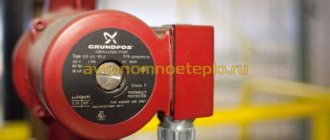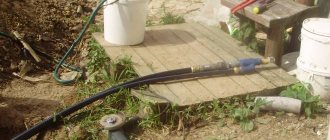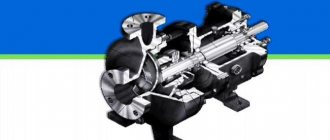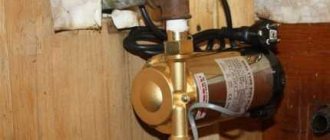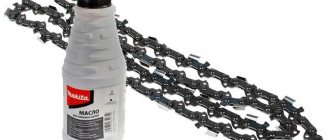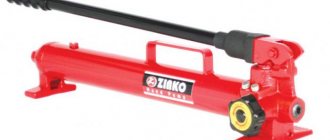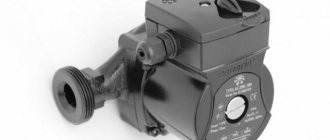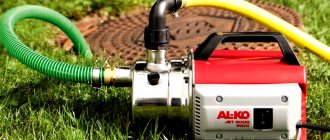Lack of hot water pressure when opening a tap is a fairly common phenomenon found in private and apartment buildings. One of the effective means of solving the problem is a circulation pump for hot water supply.
Installation of pumping equipment for hot water supply, according to existing building codes, is optional for premises with a heated area of up to 500 m²; in practice, installation may be required even if there are 2-3 separate hot water points.
For what purpose and where are recirculation pumps used?
The hot water supply system (DHW) is a closed loop of pipes. The water is heated using a boiler or boiler, or an electric heating element, and then, at the desired temperature, it circulates through the pipeline. To increase its pressure and thus increase the speed of water movement, install a circulation pump for hot water. The purpose of this device is to ensure smooth and fast circulation of water in a closed pipeline system. For this purpose, special elements of the pumping part are used.
The widest area of application of recirculation pumps is heating systems. Since they increase the speed of water movement, the heating itself becomes more economical. Water (or other liquid) acts as a heat carrier. It moves through pipes to all rooms of the house, while giving off heat and providing space heating. Then it returns to the starting point, already cooled, where it heats up again.
If you do not create pressure using a pump, then there will be no forced circulation. The water will move at low speed or stop altogether and not reach the highest points. The result will be uneven heating: some rooms are warm, while in others the pipes and radiators are cold.
DHW recirculation scheme
It is very important to create pressure in the hot water passing system, especially in large houses (over 200 sq.m.), in which water must be supplied at several points (showers, bathrooms), and there is only one heater (boiler or boiler). And it is usually located in the basement of the house or in another room on the ground floor. This results in a large length of pipes, and the water immediately begins to cool before reaching the water intake point, if its pressure is not sufficient. That is, the situation is like this - you opened the tap and are waiting for a long time for hot water to come out. In addition, if several water intake points are open, then the pressure gradually decreases, and at the very end point there may be no pressure at all. The situation is familiar to those who have a large private house, as well as residents of apartment buildings.
A DHW recirculation pump eliminates such discomfort very quickly. It creates pressure and water flows to all faucets, no matter how far they are located from the water heater.
In addition to pressure and uniform distribution, we get another important factor - saving money. After all, hot water, pushed by the pump, moves very quickly and does not have time to cool down much. That is, it is not cold water that returns to the starting point (to the heater), but rather warm water. The thermostat of a boiler or other heater analyzes its temperature and heats it up only a little, using little energy - electricity or gas. That is, the consumption of gas and electricity is reduced, so you save money.
Pump installation location
Thus, heating and hot water supply greatly benefit from installing a circulation pump. This device has also proven itself very well in underfloor heating systems using hot water pipelines. Since pipes under the floor are always thin and have very complex bends, forced circulation is simply necessary for them.
This is interesting: Submersible pumps for a well: which one is better to choose, types and features of well pumps
What are the benefits of pump heating systems?
30 years ago, so-called steam heating was common in private homes, where the coolant circulated through pipes and radiators by gravity, and the heat source was a gas boiler or wood stove. Pumps for pumping water were used in district heating networks. When compact circulation pumps for heating appeared, they migrated to private housing construction, as they provided the following advantages:
- The speed of coolant movement has increased. The heat generated by the boiler has become faster delivered to the radiators and transferred to the premises.
- Accordingly, the process of heating the house has accelerated significantly.
- The higher the flow rate, the greater the throughput of the pipe. This means that the same amount of heat can be delivered to rooms through lines of smaller diameter. Simply put, the pipelines have become half the size thanks to the forced circulation of water from the pump, which is cheaper and more practical.
- Highways can now be laid with a minimum slope and water heating circuits can be made as complex and extensive as desired. The main thing is the correct selection of the pumping unit in terms of power and pressure created.
- The household circulation pump for heating has made it possible to organize underfloor heating and more efficient closed systems operating under pressure.
- It was possible to remove from view the ubiquitous pipes that run through the rooms and do not always harmonize with the interior. Increasingly, heating communications are laid in walls, under floor coverings and behind suspended (suspended) ceilings.
Note. A minimum slope of 2-3 mm per 1 m of pipeline is needed to empty the network in case of repair or maintenance. Previously, it was made at least 5 mm / 1 m.p.
Pumping systems also have disadvantages. This is a dependence on electricity and its consumption by the pumping unit during the heating season. Therefore, if there are frequent power outages, the circulation pump must be installed together with an uninterruptible power supply unit or connected to an electric generator. The second drawback is not critical; if you select the power of the device correctly, then the electricity consumption will be acceptable.
Leading manufacturers of heating equipment, such as Grundfos or Wilo, have developed new models of units that can save energy. For example, if you buy and install an Alpfa2 circulation pump from the Grundfos brand, it will automatically change its performance depending on the needs of the heating system. True, its price starts from 120 USD. e.
New generation circulation units from Grundfos – models Alpfa2 and Alpfa2L
Design
The recirculation pump does not have much power and performance. The device pumps coolant over short distances.
Injecting high pressure from the circulation pump for DHW is not required. The product consists of a housing, an impeller and an electric motor. Under the influence of a magnetic field, when voltage is applied to the motor windings, its armature begins to rotate.
The impeller displaces a mass of water and pumps it into the outlet pipe. Liquid is drawn from the inlet pipe. When selecting a circulation pump, it is necessary to take into account its type and technical characteristics. Regardless of the manufacturer, all recirculation pumps are divided into 2 types - with a wet or dry rotor.
Dry rotor pump
In devices of this type, the water medium is located separately from the parts of the electric motor. The motor is air cooled.
Dry rotor device
A distinctive feature of units with a dry rotor is their high efficiency. Rotating parts of an electric motor require periodic lubrication. This is necessary to reduce the degree of friction between components.
With wet rotor
It’s just that this type of impeller and the armature of the electric motor are completely immersed in a water environment. Units with a wet rotor have a low efficiency.
The advantage of devices of this type is that there is no need to lubricate the rotating parts of the electric motor. Cooling of parts is carried out with water.
Recirculation pumps with a wet rotor are characterized by low noise levels during operation. This allows them to be used in residential areas, both during the day and at night. Often such devices are used in apartments and houses.
Operating principle
Circulation pumps are used to constantly move liquid in a hot water system. To connect them, it is necessary to install a storage tank. Liquid is drawn through the inlet pipe of the pump, which creates a vacuum and water from the storage tank enters the circuit.
The pump impeller pumps the liquid, building up pressure in the outlet pipe, while at the same time the cooled water flows back into the container. Thus, with constant operation of the pump, there is a continuous circulation of coolant in the system.
The principle of operation of the pump in the diagram
The hot water supply circuit does not end at the extreme point of water intake, but is connected to a storage tank. Thus, the liquid constantly circulates in the system, regardless of whether the water intake points are open or closed. For ease of use, a shut-off device can be installed on the return flow pipeline. This will shut off the circuit and stop recirculating the hot water supply if necessary.
Pump device
Since the engine stator is energized, it is separated from the rotor using a glass made of stainless steel or carbon material
The main elements that make up the circulation pump are:
- housing made of stainless steel, bronze, cast iron or aluminum;
- rotor shaft and rotor;
- wheel with blades or impeller;
- engine.
Typically, an impeller is a structure of two parallel disks that are connected to each other by means of radially curved blades. One of the disks has a hole for liquid to flow through. The second disk secures the impeller to the motor shaft. The coolant passing through the engine acts as a lubricant and coolant for the rotor shaft where the impeller is fixed.
Since the engine stator is energized, it is separated from the rotor using a glass made of stainless steel or carbon material. The walls of the glass are 0.3 mm thick. The rotor is fixed on ceramic or graphite bearings for sliding.
How can you control the pump?
Hot water from the taps in the house does not flow constantly, but is consumed according to need. That is, there is no need to constantly turn on the pump. It should turn on when needed and turn off when hot water is not needed. This gentle mode increases the service life of both the recirculation pump and the entire pipe system.
To control the pump on/off, there are two ways:
- Temperature sensors;
- Timer (time programming)
How does a temperature sensor work?
The temperature sensor is located directly in the hot water and monitors its temperature. When the degrees drop to a minimum level, the sensor automatically starts the pump motor. The temperature sensor can be adjusted to any desired temperature value, which makes it possible to save energy. If the water temperature rises to the required level (for example, 50 degrees Celsius), the sensor immediately triggers and turns off the circulation pump.
How does the timer work?
The timer also turns the pump on and off. However, it does not track the water temperature, but is programmed by time intervals. The time depends on the total length of the pipes through which hot water flows, on the performance of the pump, as well as on the quality of the thermal insulation of the premises.
The timer is especially convenient when there is no need for hot water and the residents have left for a while. Then the timer can be set to turn on and off with a period of a week. If you often have similar situations, then it is better to choose a pump with a timer, and your equipment will not run idle.
When installing a circulation pump and connecting it to the heating system or hot water supply pipes, also take into account the connection diagram. It comes in two types:
- Consistent;
- Parallel.
In the first option (series connection), the pump is connected to a closed circuit of pipes in which taps are placed in series. The second option (parallel) is less common. It involves connecting the pump to two or even three circuits using a manifold.
Adviсe
Before you start looking for pumping equipment, you need to correctly calculate the device parameters. Only after this can you decide on a purchase and invest wisely. Such data includes the workload of the water supply system, as well as sufficient flow strength. An important point is to take into account the number of taps that can be turned on simultaneously. It is necessary to create the same pressure of the circulation pump so that the pressure remains constant everywhere.
If we talk about the average water consumption at one point, it is about one hundred and eighty liters per hour. If a house or apartment has two bathrooms and a kitchen where taps are located, the best choice would be to install a device with a throughput capacity of at least 0.7 cubic meters per hour. We must not forget about the hydraulic resistance of the overall system. Pressure and pressure are affected by the length and height of the pipeline, so these indicators also need to be clarified. A water column of 0.6 meters uses 10 linear meters of contour. The manufacturer always adds technical documentation to each model and type of pumping equipment, so it is worth studying all the indicators and descriptions.
Thanks to such calculations, it is possible to obtain the average heat consumption of hot liquid through a circulation pump, which will help you quickly make a choice and facilitate the purchase. Of course, an industrial-type device is suitable for pumping water at a large enterprise, but slightly different models are suitable for a home.
Today, calculations can be made online thanks to electronic calculators, where the corresponding indicators are entered, which speeds up the solution of the problem. If a pump is selected for an apartment building or a cottage with a large area, such calculations are carried out only by qualified specialists from design and installation organizations, since they are responsible for the performance of the entire system.
To correctly install the pump in a hot water supply system, you must first study the instructions in detail and strictly follow the manufacturer’s recommendations. In addition, building codes are important and must be heeded.
To complete the installation you will need to complete the following steps:
- the installation location of the circulation device is selected. The module must be installed on the return line, which will prevent air from entering, which in turn will lead to a decrease in the functionality of the entire system;
- a check valve must be installed between the pump and the storage tank;
- shut-off valves are installed before and after the station, their number depends on needs;
- A UPS is used for connection. As soon as the power is turned off, it will ensure that the device operates in autonomous mode. The duration of its operation ranges from several hours to a day.
Of course, it is also necessary to choose an uninterruptible power supply according to certain parameters, taking into account the rules. Uniform distribution of pressure is an important task. For this purpose, special manifolds and pressure-reducing valves are used. You cannot run the electric motor idle, which will negatively affect its performance and the device will quickly fail. After installing the pump in the DHW system, it is necessary to fill the water circuit and do a test run to check the functionality of the mechanism.
The device with a wet rotor is a simple design that does not require regular inspection or even repair, which is one of the main advantages of this equipment. The only thing you need to do is clean and replace the filter if necessary. Glanded rotor pumps require maintenance once every two years. It is necessary to replace the lubricant and clean the housing for the device to operate smoothly. If desired, you can consult with qualified specialists to make the right choice.
In the next video you will find a review of the surface circulation pump GRUNDFOS UP 15-14 B.
This is interesting: Circulation pumps for heating: varieties, selection rules, installation
What indicators need to be taken into account when choosing
We begin the selection of a circulation pump for hot water supply with indicators of its performance and pressure.
- Productivity is the volume of water (or other liquid) that the pump pumps in a certain unit of time (cubic meters per hour or liters per minute);
- Pressure is the pressure created by the pump (measured in Bars, Pascals or lift height in meters).
In addition, we also take into account the technical characteristics:
- Power of the installed electric motor in W;
- Type of control (temperature sensor or timer).
Capacity depends on the length of the pipe system. If the total length of the pipeline is 40-50 meters (an average house), then a pump with a capacity of 0.2 to 0.6 cubic meters per hour will be sufficient.
The motor power should also be low so as not to waste electricity. On average, the figure for a small private house, cottage, cottage is from 5 to 10 W. For large houses with several floors, 20 W of power is sufficient.
The choice of a circulation pump for hot water supply according to the characteristics of its pressure (lift height) will be correct if one is guided by the following rules:
- For a one-story house, where the pipeline is single-level, we take a pressure with a height of water rising from half a meter to 0.8 meters;
- For a building with several floors, add the height of the water supply pipes;
- Plus - we create a certain pressure reserve, 10-20 percent.
Criteria for choosing a drainage pump
When considering how to choose a drainage pump, it is important to pay attention to some important parameters that are responsible for matching the functionality of this equipment to the stated requirements of the system. https://www.youtube.com/embed/J02Ju350xZw
Characteristics of the pumped medium
Before you begin selecting the necessary model for pumping water, you need to understand what kind of liquid medium is to be pumped. Ideally, there should be no gravel, sand or dirt. In practice, they are used in flooded areas, tanks and ponds. The accompanying documentation for each model describes the permissible values of solid fractions.
According to this indicator, they are divided into varieties:
- pumping water with fragments up to 5 mm;
- transportation of medium-contaminated liquids with possible fractions up to 25 mm;
- for more contaminated environments with possible fragments up to 38 mm.
In addition, it is important to take into account the temperature of the transported substance and its chemical composition. After all, for operation with aggressive components you will need to select drainage pumps with special technical capabilities
Materials used in production
The materials used determine the degree of reliability of the entire structure. The housings of water pumping units can be made of metal or durable plastic:
- Metal products are characterized by increased strength and provide more opportunities for the use of repair operations to restore functionality. This allows you to extend their service life.
- Durable plastic makes it possible to reduce the overall cost of equipment, which is considered an attractive factor for the average person.
No less important is the type of material for the production of working parts of drainage pumps for dirty water, namely the blades of the rotating element. They are made from stainless alloys and polymers with unique capabilities.
It is considered the best, high-quality polymer, it can be used under heavy loads. However, such elements cannot be repaired. Stainless steel is much cheaper and wears out faster.
Circuit breaker type
Basically, drainage pumps are equipped with automatic switches that can turn on the mechanism when the liquid reaches the required level.
They may look like:
- an electronic special device, which is an expensive component;
- devices using a float, considered a cheaper alternative.
All of them are triggered to stop the flow of water, turning off the electric motor, thereby protecting it from overheating.
Drain pump performance
This concept denotes the volume of a substance transported over a fixed time period:
- to meet household needs, approximately 10 m³/h is enough;
- for professional use, more powerful devices with an indicator of more than 100 m³/hour are selected.
This is an important indicator, it is indicated in the attached documents.
Pressure of the device for pumping water
The average drainage pumps produce a stream of 5-50 meters:
- this indicator depends on the type of pumping equipment used; it indicates the permissible lifting height and the distance of its movement on a horizontal surface;
- this is an important operational characteristic indicated in the accompanying documentation;
- as a rule, it is calculated in a ratio of 1:10;
- if the lift height is specified as 6 meters, then the horizontal removal distance is equal to 60 m.
Naturally, this characteristic will be influenced by the diameter of the hose for transporting liquid. For a household appliance, a lifting height of several meters greater than the depth of the storage tank will be quite sufficient. It is always necessary to calculate this indicator with a reserve.
Recommendations for proper pump installation
To ensure convenient access for servicing the pump, the unit must be connected correctly. In practice, when installing a pump, the following basic installation rules should be taken into account:
After installing the circulation pump, it should always be accessible so that in the event of a breakdown, it can be easily repaired or replaced.
- Both sides of the pumping unit must be equipped with special ball valves, which are necessary when carrying out maintenance of the entire heating system or during the dismantling of the unit.
- It is necessary to equip the entire system with a filter in order to protect the device from exposure to small particles that lead to damage to the installation and its components.
- Since the water passing through the heating system is far from ideal, additional protection will be required for the pumps to function properly. Therefore, the heating bypass on top must be equipped with a valve, which must be installed. You can choose any valve: automatic or manual. Its purpose is to release air pockets formed in the pipes; its terminals should be directed clearly upward.
- Belonging to the type of wet models, the pump must be installed in a horizontal position so that it is completely immersed in water, and not just a separate part. Incorrect installation can cause damage to the working surface of the unit, and the installation will be pointless.
- To increase the operating potential of the structure, it is necessary to specially treat all fasteners and connections in the system with a sealing agent.
- It is necessary to ensure that the sequence is observed when connecting the pump and fasteners.
Performance calculation
First, we take the value of the required heat for heating equal to 70 - 100 W per 1 square meter of room area. Next, we carry out the calculation using the formula: the required pump performance is equal to the power of the entire heating system, multiplied by 0.86, and divided by the difference in coolant temperatures at the inlet and outlet.
In standard writing, the formula looks like this:
Q=P×0.86/(Tf-Tr)
Where:
- P - boiler power in kW,
- Tf – output temperature, (for example 90 C)
- Tr – return temperature.
Calculation example: house with an area of 100 m. Boiler 10 kW, water output from the boiler - 70 C, return flow - 50 C (20 C difference).
This means we get: 10: 0.86 = 8.6 (70-50=20) = 0.43 m/hour (8600:20). The calculation is quite simple and universal.
Varieties
There are two types of recirculation pumps for domestic hot water:
Place of the pump in the DHW system
- reverse (installed on the pipeline for return water supply);
- supply (mounted on pipes for supplying hot water from the heater).
Both of these types are used in closed loop systems.
Based on their design features, units providing hot water supply are divided into two types:
- Units with wet rotor. In this type of recirculation pump, the pressure part is located inside the pumped liquid. Water performs the function of lubrication and cooling. Such devices have a long service life and low noise operation. They do not require maintenance and are affordable. The disadvantages of this equipment include low efficiency (40-45%), as well as the method of installation only in a horizontal position. Used in small houses for heating and water supply systems. Capable of creating pressure up to 1.5-3 atm.
- Devices with dry rotor. In such pumps, the power unit and the pumped liquid are separated from each other. Circulation pumps with a dry rotor require periodic inspection, during which lubrication is carried out. There is a built-in fan to cool the engine. The cost of maintenance and the device itself is higher than a unit with a wet rotor. But productivity is also higher, it is about 70%. The pressure is increased to 5-10 atm. Disadvantages include increased noise levels during operation and high cost. Used in industry and for centralized heating and water supply systems.
Depending on the switching speeds, there are the following models:
- multi-speed - switches the operating algorithm. Used in houses with a large area, more expensive;
- single-speed - have reduced performance, suitable for domestic use. Easy to install and work independently.
Model selection
The main task of the recirculation pump is to maintain the optimal speed of hot water through the pipeline, at which the temperature of the water in the return pipe will be within the required limits. The choice of unit is made taking into account the following parameters:
Calculation of parameters for choosing a DHW pump
- the maximum pressure of a liquid, which is measured by the height of the water column. Pressure affects the pressure and temperature of water circulating through the pipeline;
- fluid consumption. The formula calculates the difference in water temperature between the supply and return pipes. The power of the heating equipment is divided by the resulting number;
- heat transfer of the heating system. It is calculated depending on the area of the room that is heated and the expected heat loss.
The recirculation electric pump must be selected taking into account these parameters. This is the work of an experienced designer.
Wilo Star-RS 25/4-180
Photo: https://beru.ru
The German pump Wilo Star-RS 25/4-180 is popular among domestic homeowners. In just 2 months, 2187 people in the nuclear field were interested in this device. The model is designed for small heating systems. The device consumes only 48 W of electricity, delivering a maximum head of 4 m and a throughput of up to 3 cubic meters. m/h. The model looks reliable, the cast iron body and stainless steel shaft will ensure a long service life. The pump earned high marks from experts for its quiet operation and the presence of a speed switch.
Circulation pump Wilo Star-RS 25/4-180 (48 W)
Advantages:
- reliability and durability
- silent operation
- economical energy consumption
- affordable price
Flaws:
- modest performance
Purpose and scope
Hot water recirculation pumps have a very important function. With the help of such devices, closed pipelines through which hot water is transported operate in the required mode. By pumping liquid into the pipeline due to the rotation of special elements, recirculation electric pumps increase the pressure of the liquid medium they pump and, accordingly, the speed of its movement.
Most often, heating systems are equipped with recirculation pumps, which increases not only the efficiency, but also the cost-effectiveness of the latter. Most of these systems, as is known, operate using a coolant, which, moving through a pipeline, releases heat into the room. Heating of the coolant (in this case, before it is supplied to the pipeline) is provided by a boiler, boiler or water heater. After passing through the entire heating circuit, the water must return to the heating equipment, where it is again given the required temperature.
DHW recirculation scheme
Without the use of special pumping equipment, water circulation in the heating system will flow slowly, and in some cases may not flow at all, since the pressure of the coolant flow, which is not further increased in any way, will be dampened by the pipeline elements. The result of this is unevenly heated heating pipes and, accordingly, an uncomfortable temperature in the premises of the house.
A circulation pump for hot water supply increases the pressure and pressure of hot liquid moving through a closed pipeline circuit. The use of circulation pumps for hot water is especially important in the pipeline systems of houses with an area of more than 200 m2, in which there are several water intake points, and the boiler is installed in a separate room or in the basement. Water in such pipelines (as a rule, quite long), if they do not have a recirculation system using a special pump, cools down quite quickly. This leads to the fact that when you open the tap you have to wait a long time until liquid heated to the required temperature flows out of it.
In addition, when some taps at water intake points are opened immediately, the water pressure in them drops, because the pressure of the liquid moving through the pipeline by gravity is not additionally supported by anything. To solve precisely these problems faced by owners of private and apartment buildings, a hot water pump is designed to provide forced movement, as well as the creation of stable water pressure and pressure in the hot water supply system.
The recirculation pump should not be installed near tanks or water heaters, the heat from which could affect the thermostat.
Using a circulation pump for heating and hot water supply to a private home, in addition to the above advantages, allows you to save on energy costs. Since in systems with recirculation, water from the boiler is transported through pipes forcibly and reaches all water intake points and heating radiators much faster, its temperature during such transportation decreases slightly. A boiler, if forced water recirculation is provided in the pipeline it serves, requires less time to heat it, and accordingly, the consumption of energy carriers used to operate the heating equipment is reduced.
Pumps for circulating hot water are actively used to equip “warm floor” systems, the design of which assumes the presence of an extended pipeline circuit of a complex configuration, consisting of small-diameter pipes. In such cases, the circulation pump ensures constant movement of the coolant through the pipes.
The circulation pump is a mandatory element of the underfloor heating system
DAB EVOTRON 40/180
Photo: https://beru.ru
The Italian circulation pump DAB EVOTRON 40/180 is designed to work in air conditioning and heating systems. The manufacturer has used advanced electronic rotation speed control. Thanks to this, the pump's performance can change automatically, which has a positive effect on energy efficiency. Sleep mode allows you to save electricity. Experts note the presence of thermal insulation of the housing in the kit and minimal power consumption (27 W). The maximum head is 4 m, and the throughput is limited to 4 cubic meters. m/h.
Circulation pump DAB EVOTRON 40/180 (27 W)
Advantages:
- quiet operation
- automatic speed control
- low power consumption
- high-quality assembly
Flaws:
- high price
Unit features
The principle of operation of circulation pumping equipment is based on creating continuous circulation of liquid in the system without changing the pressure indicator
A circulation pump is a device that operates in a closed heating system and moves water in a pipeline. The unit maintains a certain temperature of the coolant in the system. The device does not replenish coolant losses and does not refill the system. The system is filled using a special pump or a certain pressure in the pipes.
The principle of operation of circulation pumping equipment is based on creating continuous circulation of liquid in the system without changing the pressure indicator. Since after installation the device operates constantly, the main requirements for such pumps are low noise level during operation, economical energy consumption, reliability, durability and ease of use.
Important: circulation pumps are compact devices that do not take up much space and do not create noise during operation. The scope of use of circulation units for heating systems is quite extensive.
They are installed:
The scope of use of circulation units for heating systems is quite extensive. They are installed:
- in traditional radiator systems;
- when installing a water heated floor;
- in geothermal systems;
- when organizing hot water supply for cottages and dachas.
Unlike forced circulation systems, this pumping equipment does not require pipes with an increased diameter. In addition, the device has the following advantages:
- speed of heating the room;
- the boiler can be installed in any suitable place;
- coolant losses and air pockets are minimized;
- The thermal relay ensures automatic control of temperature conditions;
- Electricity costs are reduced due to the use of automatic rotor speed control;
- Since liquid is constantly supplied to heating devices, their service life is extended.
Differences between circulation pumps for domestic hot water and heating
The use of a circulation pump in a hot water system has certain nuances that distinguish it from the use of stations in water heating circuits. So the circulation equipment for one system often cannot be used for another of them.
Features of circulation pumps:
· efficiency. The power of the heating pumps is too high for domestic hot water. If necessary, circulation heating circuits can be installed on the “analogue” for water. On the contrary, it is never possible. Some manufacturers provide for this, and therefore, just for this case, they produce twin pumps with two electric motors. This allows you to connect the device simultaneously to heating with DHW;
· frame. Heating and domestic hot water pumps also differ in the housing material. The former are made of cast iron, and the latter are made of brass, and are closed on top with a special casing for thermal insulation;
· heating water. Devices for hot water supply can withstand operating water temperatures of more than 65 degrees above zero. But in heating systems the water heats up to 90-95 degrees.
So, these two types of devices are not interchangeable. The only exception is “twin pumps”, which are produced by many leading European companies.
Control method
Maintaining the circulation of hot liquid at all times is acceptable, although this is not always economically justified. Many will agree that there is not always a need for such water, so there is no need for the pump to work non-stop. If the pipes are routed correctly and thermal insulation is installed, the liquid will not immediately cool down. As far as monetary costs are concerned, this will not affect them since recirculation pumps are inexpensive to maintain.
The control method can be by timer, that is, schedule, and by temperature sensors.
The most common types of breakdowns and how to fix them
The most common type of breakdown is the impeller stopping. The device hums but does not work properly. To solve the problem, you need to turn off the circulation, drain the water, disassemble the device and move the impeller. Typically, the cause is the adhesion of small particles or the entry of foreign objects into the flow.
The second most common type of malfunction is overheating . It occurs due to lack of lubrication on the bearings or due to the regular entry of air into the system. The problem can be solved if the rotating parts are well lubricated and all connections are reliably sealed.
Everything you need to know about hot water is presented in this section of the site.
Connecting equipment
This equipment is installed on direct or return pipes. For heated floors, it is better to connect a pump to the return pipe to stimulate water movement.
For long-distance hot water pipelines, it is recommended to install them on a direct supply pipe. Then all residents of the house will receive hot water in the required quantity.
Circulation pump installation steps:
- assembly of the mechanism using the included instructions;
- choosing a location for installation;
- water supply shutdown;
- cutting and removing part of the pipe;
- connecting the pump using flanged or threaded connections;
- sealing joints;
- connection to the electrical network;
- setting up operation and testing the mechanism.
Recirculation pump (DHW) WILO STAR-Z NOVA A
To achieve maximum functionality of the system, it is recommended to install the pump in a pocket. This is a pipe branch cut off by shut-off valves. In this case, the system can be easily switched off and dismantled if necessary, and the coolant is reoriented to the central branch.
Installation Tips
When installing the pump, keep the following points in mind:
- The device is installed only after complete removal of air from the system and filling it with water. Dry running will damage the device;
- when installing devices with a wet rotor, the shaft must be in a horizontal position;
- You cannot install a pump with a higher capacity than necessary. Otherwise, noise will appear in the pipes;
- before starting, the system is thoroughly flushed;
- you need to make sure that air can be removed from the pipes and pump;
- equipment with a thermostat cannot be mounted near heating tanks, they will overheat the device;
- with a closed system, the unit is installed on the return line, where the water temperature is lowest.
Model for DHW WILO STAR-Z NOVA (VIDEO)
Launch rules
After installation of the unit, startup is carried out. To do this, perform the following steps:
- water pipes are filled with water and static pressure is created in the system;
- an automatic air vent or tap removes air from the mechanism;
- the heater turns on;
- the pump is turned on and the water circulation through the pipes is checked;
- After a few minutes of operation, the pump turns off and the remaining air is removed from the system.
The most common types of breakdowns
Failure can occur for several reasons:
- dry running - pump operation without coolant is prohibited;
- water hammer - to avoid it, the pump is manually filled with liquid before starting;
- water freezing - when the device is not in use, the liquid is drained.
With proper installation and operation of the pump, it will work properly for a long time.
How to make the first launch?
The first start-up, as a rule, is made after the device is fully connected, the entire line is assembled and filled with water.
It is prohibited by the instructions to turn on the pump dry. This is fraught with breakdown and failure, as well as refusal of the warranty workshop to carry out repairs.
Before starting, you need to make sure that the system is completely ready for use. Most designs automatically remove air when a special screw is turned.
You need to unscrew it half a turn (or more) and wait a few seconds until the air comes out and water flows out. For other pumps it is necessary to install a special air venting element (Maevsky valve).
